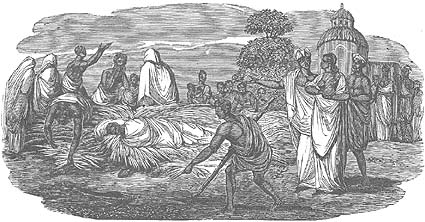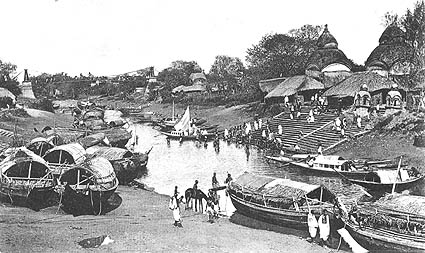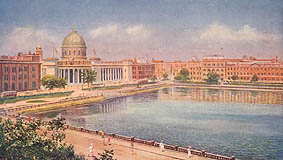Kali Another form of Durga. Her hair is
disheveled, her tongue hangs out, she holds in one hand a scimitar,
in the other a skull, with another she forbids fear, and with
the last is bestowing a blessing. Her four arms represent the
4 vedus; the two inspiring terror point out those portions of
the vedu which relate to the destruction of enemies, and the
other two allude to those parts which belong to devotion. Her
dishevelled hair represents the clouds, her tongue is representative
of lightning. She exhibits the appearance of a drunken frantic
fury. She is the protectress of thieves, and her image at Kali
Ghat is a head without a body. (9)
Kali Ghat the temple devoted to Kali on
Tolley's Nullah, in South Calcutta. It is the most sought after
cremation site where bodies are burnt on sandal wood, goats are
sacrificed daily, and flowers and fruit are offered to Kali by
devotees.
Kanarese of Kanara in western India:
their Dravidian language, now called Kannada, is akin to Telegu.
Koran the sacred text of Islam, the infallible
word of Allah, as revealed to the profit Mohammed; the primary
source for Islamic law.
Krishna an incarnation of the god Vishnu.
Kshatriya under the Hindu caste system,
the second of the four varnas, to which warriors belonged.
Kulin a high-caste Brahmin.
Kyast one of the 'writer' caste.
Lakh the number 100,000; usually written as
1,00,000.
Laudanum an alcoholic tincture made with
opium, used at one time for medicinal purposes.
Leadenhall Street India House, the headquarters
of the East India Company in the City of London.
Lepcha a member of a hill tribe living in Sikkim.
Lingam the worshipped symbols of the organs of
reproduction.
Mali a gardner.
Maratha, Mahratta a people of west-central India;
a person who speaks the Marathi language; a loose confederation
of Hindu rulers in west-central India whose soldiers were especially
well trained and equipped.
Marathi, Mahratti the Sanskritic language of the
Maratha people. Maharastra in Sanskrit means great kingdom.
Mahratta Ditch a defensive canal to the north-east
of Calcutta, built in 1742, at a cost of 25,000 rupees, and designed
to provide protection from attacks by the Marathas. It was intended
to create a complete arc around Calcutta but was never finished
as the threat from the Marathas receded. The salt lakes gave
protection to the south and the Hooghly gave protection to the
west. (10)
The Maidan a wide open space in the heart
of Calcutta, dangerous for anyone with a touch of agoraphobia.
Twice as big as Regent's Park, London, as it covers 2 square
miles of parkland. Originally designed as a defensive area around
the new Fort William to avoid the mistakes of the original where
attackers could fire into the fort from the mansions of rich
English merchants that had been built too close to the walls.
Masjid a mosque.
Mela a religious fair.
Memsahib a title of respect for the mistress
of a household.
Moghul a descendent of that group of nomadic
herding and hunting tribes from the steppes of central Asia who
conquered India in 1526.
Moghul empire the great imperial dynasty founded
in 1526 by Babur, king of Kabul, with its capital at Agra. The
empire ruled India until the 18th century.
Mohurrum the anniversary of the death on
the battlefield of Hussan and Hussein, the two sons of Ali, the
adopted son of Mohammed.
Monsoon in Bengal the summer monsoon
blows from the Bay of Bengal for 4 months, and brings with it
stifling heat, strong winds and torrential rains.
Munshi a language tutor.
Nabobs a name given to English East India Company
employees who prospered in India and flaunted their newly acquired
wealth back in England.
Nawab a Muslim ruler in the Moghul empire, usually
either a provincial governor, or a prince.
Oriya the language of Orissa, closely akin to
Bengali.
Paita the sacred thread worn by the three higher
castes the priests, the warriors and the merchants.
Palanquin a covered or enclosed litter,
usually for one person, carried on curved bamboo poles on the
shoulders of four or six bearers.
Pan a slightly intoxicating mixture of areca
nuts, lime, and spices, wrapped in a betel leaf and chewed to
aid digestion. The residue forms a red liquid in the mouth and
is spat out.
Panchway a vessel suitable for navigating
Bengal's shallow waterways, with a low roofed shelter for protection
from the sun and rain, but no seats.
Parganas, 24 nine hundred square miles of
land, south of Calcutta, annexed by Robert Clive after the Battle
of Plassey in 1757. It was to provide Clive with an income of
£30,000 a year till the day he died. (11)
Particular relating to Baptists. The doctrine
that salvation is offered only to particular individuals, the
elect, and not to the race. (12) In 1633 the Particular
Baptists were founded. They were a group whose Calvinistic doctrine
taught that atonement is particular or individual. Immersion
was not yet insisted upon in these churches, but in 1644 seven
Particular Baptist churches issued a confession of faith requiring
that form of baptism, and Baptist was thenceforth the name given
to those who practiced it.
Peepul one of the sacred trees of India, with
a long pointed leaf.
Peon a messenger.
Phaeton a light, four-wheeled carriage
containing one or two seats and drawn by a pair of horses.
Pice a coin; a quarter of an Anna.
Pinnace the same as a budgeree
(see above).
Puja Hindu ceremonial worship, ranging from
simple private daily prayers, to elaborate temple rites and festivals,
conducted by one or more priests, with its rituals varying widely
depending on the occasion.
Pundit a Brahmin scholar or religious teacher.
Punkah a fan suspended from the ceiling, made
either from a large palm frond, or of cloth held in a large rectangular
frame, powered by a servant using a cord and pulley system.
Punkah-wallah a servant who operated the punkah.
Pushtu, Pashtu, Pushtoo,
Pashto, Pakhtu, Pakhto
the language of the Afghans.
Radha a consort of Krishna.
'Ramayana' one of India's two great religious
epics.
Residency the compound where the Resident
and his staff lived and worked.
Resident a British official attached
to the court of an Indian ruler in a supposedly advisory, but
often a dominating, capacity.
Rupee a coin or note, made up of sixteen annas;
the basic monetary unit of India. In Ward's day a rupee was worth
approximately 2 shillings and 10 pence.
Ryot a peasant.
Sadhu a Hindu holy man, ascetic and mendicant.
Possibly, under a tree, in a dirty sheet, with mud smeared on
his arms and the white mark of Vishnu painted on his forehead,
leaning on his quarter staff with his begging bowl in one hand,
always in the same spot whenever you pass. (13)
Sahib a title of respect equivalent to "sir";
a form of respectful address for a European, or an Indian man
of rank in colonial India.
Sanskrit the ancient, classical Indian
language of India in which most of the texts of Hinduism were
written, and from which most of the spoken languages of northern
India are derived.
Sari an outer garment worn by a woman consisting
of a single length of cotton or silk, 5 to 7 yards long, most
often with one end wrapped around the waist to form a skirt,
the other draped over the shoulder, or head.
Sepoy a Hindu or Muslim soldier armed and trained
in the European manner by British officers, and serving, under
British command, in native battalions in the army of the East
India Company
Shastras sacred Hindu books that regulate
religious, social and professional behaviour and activities.
Shiva the Destroyer; one of the divine triumvirate
of Hindu mythology. The others being Brahma the Creator and Vishnu
the Preserver.
Soodra under the Hindu caste system, the fourth
and lowest recognized varna, the servant and labouring class
that served the three upper classes.
Subahdar major the senior Indian officer in
a native regiment of the British service.
Subaltern a British officer equivalent
to a lieutenant.

'Burning of Widows',
an illustration from an American edition of 'A view of the History,
Literature and Religion of the Hindoos', by William Ward, Hartford,
1824. Courtesy Derby
Local Studies Library.
Suttee the Hindu practice of burning widows alive
on their husband's funeral pyre.
'When the husband is directed
by the physician to be carried to the river side, there being
no hopes of his recovery, the wife declares her resolution to
be burnt with him. In this case, she is treated with great respect
by her neighbours, who bring her delicate food, &c. and when
the husband is dead, she again declares her resolution to be
burnt with his body. Having broken a small branch from the mango
tree, she takes it with her, and proceeds to the body, where
she sits down. The barber then paints her feet red; after which
she bathes, and puts on new clothes. During these preparations,
the drum beats a sound, by which it is known, that a widow is
about to be burnt with the corpse of her husband. On hearing
this all the village assembles. The son, or if there be no son,
a relation, or the head man of the village, provides the articles
necessary for the ceremony.
A hole is first dug in the
ground, round which stakes are driven into the earth, and thick
green stakes laid across to form a kind of bed; and upon these
are laid, in abundance, dry faggots, hemp, clarified butter,
pitch etc. The officiating brahmin now causes the widow to repeat
the formulas, in which she prays, that "as long as fourteen
Indrus reign, or as many years as there are hairs on her head,
she may abide in heaven with her husband; that the heavenly dancers
during this time may wait on her and her husband, and that by
this act of merit all the ancestors of her father, mother, and
husband, may ascend heaven." She now presents her ornaments
to her friends, ties some red cotton on both wrists, puts two
new combs in her hair, paints her forehead, and takes into the
end of the cloth that she wears some parched rice and kourees.
While this is going forward,
the dead body is anointed with clarified butter and bathed, prayers
are repeated over it, and it is dressed in new clothes. The son
next takes a handful of boiled rice, prepared for the purpose,
and, repeating an incantation, offers it in the name of the deceased
father. Ropes and another piece of cloth are spread upon the
wood, and the dead body is laid upon the pile. The widow then
walks around the pile seven times, strewing parched rice and
kourees as she goes, which some of the spectators endeavour to
catch, under the idea they will cure diseases.
The widow now ascends the fatal
pile, or rather throws herself down upon it by the side of the
dead body. A few female ornaments having been laid over her;
the ropes are drawn over the bodies which are tied together,
and faggots placed upon them. The son, then, averting his head,
puts fire to the face of his father, and at the same moment several
persons light the pile at different sides, when women, relations,
&c. set up a cry: more faggots are now thrown upon the pile
with haste, and two bamboo levers are brought over the whole,
to hold down the bodies and the pile. Several persons are employed
in holding down these levers, and others in throwing water upon
them, that they may not be scorched. While the fire is burning,
more clarified butter, pitch, and faggots, are thrown into it,
till the bodies are consumed. It may take about two hours before
the whole is burnt, but I conceive the woman must be dead in
a few minutes after the fire has been kindled.' (14)
For more details and examples
see the Digital Library Page.






